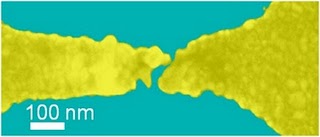Shortly after reading of MIT’s 100-fold breakthrough in light-gathering capabilities for solar cells, we saw the news about a one-thousand-fold increase claimed by Rice University researchers. Professor of physics and astronomy Doug Natelson announced the findings of his research group, which includes his graduate student Dan Ward, and colleagues in Germany and Spain.
In his blog, Natelson stated, “My student (with theorist collaborators) had a paper published online in Nature Nanotechnology yesterday, and this gives me an excuse to talk about using metal nanostructures as optical antennas. The short version: using metal electrodes separated by a sub-nanometer gap as a kind of antenna, we have been able to get local enhancement of the electromagnetic intensity by roughly a factor of a million (!), and we have been able to determine that enhancement experimentally via tunneling measurements.”
In a brief discussion with this reporter, Natelson deflated any ideas that this technology would be powering up solar cells in the near future. Noting that other researchers, such as those at MIT, have used long filaments as antennas to trap light for longer periods to enhance solar cell performance, he explained that his very specifically-tuned gold nano-antenna works so far in a narrow range, from 700 nanometers to the lower part of the infra-red range of light, and only for a nano-instant.
“White light” associated with sunlight has a broad spectrum of wavelengths, and these ranges would have to be investigated in narrow bands with lenses and mirrors optimized for those wavelengths. This time-consuming and costly process would require at least a six-figure grant or beneficent resource to allow characterization of the device’s potential for the broader spectrum of light.
When asked about the efficiency of his antenna he stated, “It’s terrible,” at least partly because of the finite nature of the burst of energy released, rather than the long meanders that photons take through other collectors. Natelson cautioned that, “Before we get too excited,” about the potential for creating super-powerful solar collectors, there are possible near-term applications in areas such as photochemistry and photocatalysis. In both those instances intense bursts of energized light could create photochemical reactions, such as splitting water molecules into oxygen and hydrogen – bringing us indirectly to another potential energy source.
In his blog, Natelson explains the lure of exploring these near-quantum areas. “When you think about it, it’s pretty amazing. The radiation intensity in the little nanogap between our electrodes can be hundreds of thousands or millions of times higher than that from the incident laser. Wild stuff, and definitely food for thought.”

